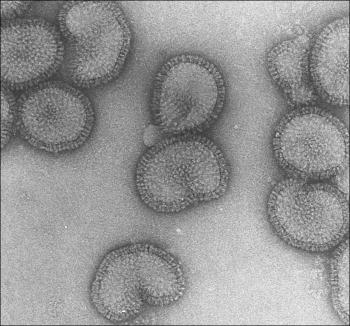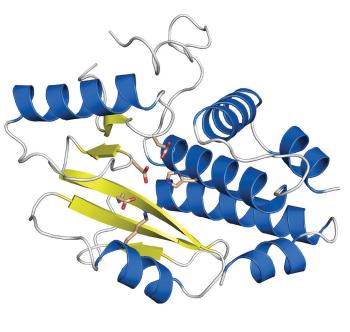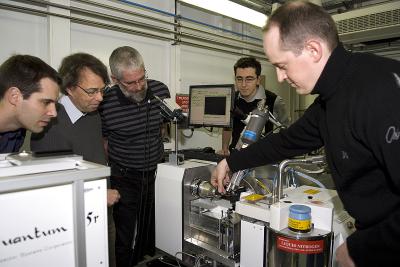- Home
- News
- General News
- The deadly knife...
The deadly knife of the influenza virus made visible
04-02-2009
Scientists take a major step towards development of effective drugs combating flu
Share
PRESS RELEASE- To replicate itself, the influenza virus takes over control of several key processes in the human cells and exactly how this is done is a long-standing subject of scientific enquiry. In this week’s Nature, a high-resolution image of a part of the virus shows how the virus hijacks the cell’s RNA molecules for its own purposes, opening a new approach to drugs which inhibit this action. New drugs and vaccines against influenza are indeed desperately sought as seasonal epidemics kill several hundred thousand people every year and a global pandemic looms if bird flu strains develop the ability to infect humans easily.
Researchers at the European Molecular Biology Laboratory (EMBL) and the Unit of Virus Host-Cell Interaction (UVHCI), jointly set up by University Joseph Fourier (UJF), EMBL, and the National Centre for Scientific Research (CNRS), in Grenoble, France, have produced crystals of crucial viral domains and examined their structure with the powerful X-ray beams of the European Synchrotron Radiation Facility (ESRF). The three-dimensional structural images show on the atomic scale the location of a “knife” crucial to the virus’ function. These findings are the culmination of a research effort that begun more than twenty years ago. The breakthrough dates back to 2006 when the group succeeded producing crystals of a quality suitable for X-ray analysis of atomic structures.
When an influenza virus infects a host cell, it steers the cell’s machinery towards synthesing viral proteins rather than producing the proteins which the cell itself needs. To this end, a part of the virus called polymerase steals a small piece of host cell genetic material (mRNA) and adds it onto its own genetic code. This piece, the “cap”, has the function of a key, turning on the host cell's protein-synthesis machinery to work for the virus. But which of three suspected protein domains in the polymerase does what in the collective piracy remained controversial. The team in Grenoble has now discovered that a protein domain called PA is responsible for cleaving, or cutting the cap off the host mRNA.
“Our results came as a big surprise, because everybody thought that the cleaving activity resides in a different part,” explains Rob Ruigrok, vice-director of the UVHCI.
“These new insights make PA a promising antiviral drug target. Inhibiting the cleaving of the cap is an efficient way to stop infection, because the virus can no longer multiply. Now we know where to focus drug design efforts,” adds Stephen Cusack, head of EMBL Grenoble and director of the UVHCI.
The high-resolution images of the viral domain reveal the individual amino acids that constitute the active site responsible for cleaving the RNA: the hollow canyon in the centre captures the long mRNA strand and the metal complexes at the top edges of the canyon cut off the cap. An experiment carried out at the ESRF confirmed that these contain manganese, providing an important hint for drug development.
“A key aspect of the discovery was the close distance between the institutes. The ESRF is a neighbour to the UVHCI and the Grenoble outstation of EMBL. The rapid access to X-ray beam time and the development, jointly with EMBL, of beamline automation allowed the scientists to perfect their crystals to reach the necessary quality very efficiently,” says Sine Larsen, Director of Research at the ESRF.
Only a few months ago the same group of scientists has already identified the structure of another key part of the influenza-host cell interaction; a nearby domain called PB2 that recognises and binds to the cap of the host cell. Taken together the two findings provide a close-to-complete picture of the cap snatching mechanism that allows the influenza virus to take control over human cells.
Reference:
Dias, A. et al, The cap-snatching endonucleaseof influenza virus polymerase resides in the PA subunit, Nature, 4 February 2009.
AUDIOVISUAL MATERIAL
There is a video available at http://www.esrf.fr/Apache_files/press/Influenza.mov.
IMAGES IN HIGH RESOLUTION:
http://www.esrf.fr/Apache_files/press/surface.jpg: 3-D image of the PA protein domain where the cleaving of human genetic code by the virus takes place. The canyon is in the centre. The colours denote the electrostatic charge at the surface of the protein complex. Copyright EMBL-UVHCI
http://www.esrf.fr/Apache_files/press/Crystal.png: Photo of one of the crystals used to determine the atomic structure of the PA protein domain. Copyright EMBL-UVHCI
http://www.esrf.fr/Apache_files/press/Diffractogramme.png: Diffraction pattern of the crystal, obtained at the ESRF. Copyright EMBL-UVHCI
http://www.esrf.fr/Apache_files/press/research.jpg: European research campus in Grenoble. The ESRF is to the left of image, and the two buildings hosting EMBL and UVHCI are in the centre. Credits: P.Ginter/ESRF.
http://www.esrf.fr/Apache_files/press/structure.tif: High resolution image of the key domain of the influenza virus polymerase. The active site responsible for RNA cleavage is shown in red. Its activity is crucial for the virus to multiply in human cells. Credits: Stephen Cusack/EMBL.
http://www.esrf.fr/Apache_files/press/TeamID23.jpg: Group photo of the scientists at the ESRF beamline ID 23 where the measurement of the atomic structure was made. From left to right: Alexandre Dias, Stephen Cusack, Rob Ruigrok, Denis Bouvier and Thibault Crépin. Credits: ESRF
http://www.esrf.fr/Apache_files/press/Influenza-Virus.jpg: An electron microscopy image of the flu virus. Credits: Rob Ruigrok/ UVHCI.
Top image: 3-D image of the PA protein domain where the cleaving of human genetic code by the virus takes place. The canyon is in the centre. The colours denote the electrostatic charge at the surface of the protein complex. Copyright EMBL-UVHCI







